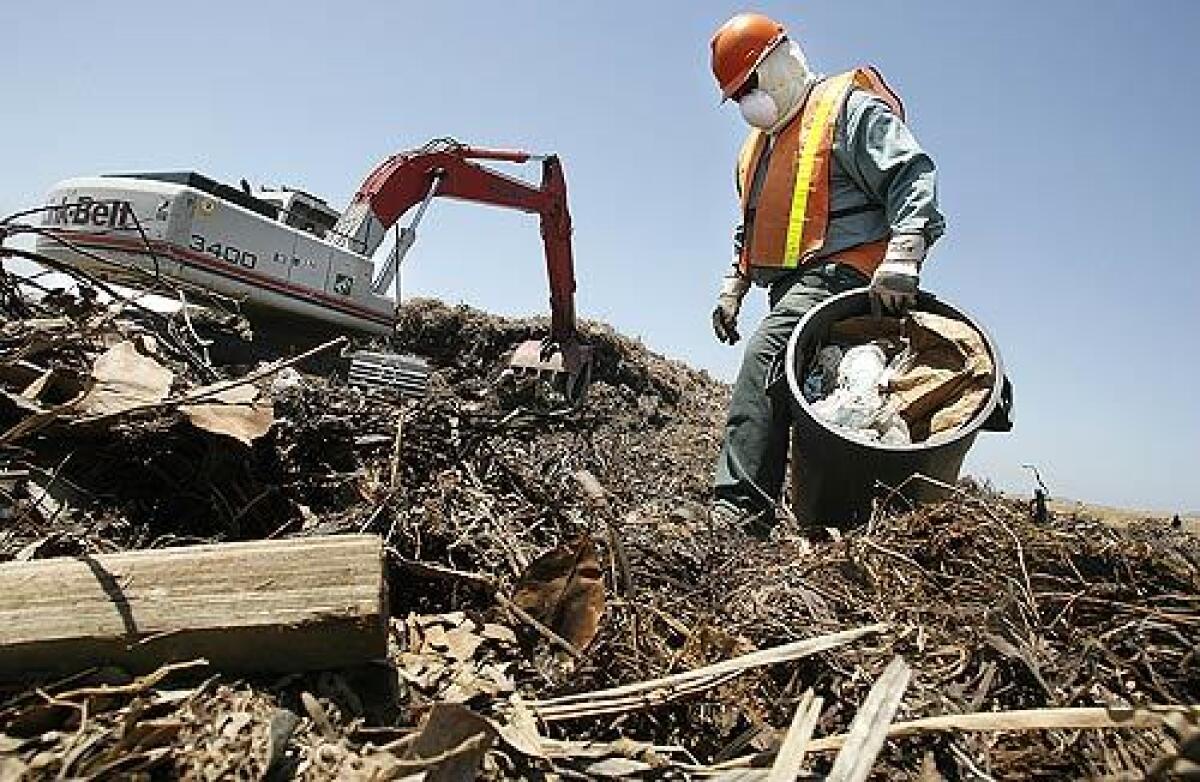Ecology is just part of the daily grind at the former Marine base

For months, mammoth grinders have been busily chewing up what little remains of the old El Toro Marine base.
But instead of trucking tons of wood and glass from hangars and barracks to the county landfill, Irvine-based Tierra Verde Industries is in the midst of an extraordinary recycling project: reducing 300,000 tons of Marine history to mulch and topsoil.
“See that pile of wood,” said Arthur Kazarian, pointing to a half-acre stack that looked like a kindling pile Paul Bunyan might have left behind. “We’re going to grind that down into chips and make mulch.”
Kazarian, 72, the owner of Tierra Verde, has been in the recycling business for more than three decades. In Los Angeles, he was a wastepaper broker who made money salvaging IBM cards. For a decade, he and his son, Kris, have targeted green waste in Orange County.
Now, they’re turning their attention to the former base. It was officially closed eight years ago but is set to begin a new life as a planned community encircling a vast urban park. The park alone is expected to cost more than $1 billion to develop.
The Lennar Corp. paid the U.S. Navy $649.5 million for the base in 2005 and then transferred more than 1,300 acres to Irvine for the Great Park.
The salvage and recycling operation is one of the largest ever undertaken in the United States, according to Lennar and Irvine officials. Part of the work includes ripping out El Toro’s four concrete runways, an estimated 3.5 million tons of asphalt and concrete that will be crushed and recycled into miles of new streets and sidewalks in Lennar’s development.
For Tierra Verde, it means that as the demolition progresses, construction rubble will be trucked to a corner of the former base where the firm is leasing 50 acres for its recycling operation. Here the rubble is mixed with green waste that the firm collects from curbside residential containers in central and southern Orange County and is sorted to remove metals, plastics and other debris.
Kazarian, 42, says the company can get about 25% to 30% of recycled product out of all the materials it combines and composts. The firm makes 14 products from the waste, including mulch and topsoil, he said.
The process is simple but costly because of labor rates and the use of specialized machinery, Kazarian said. After green waste arrives, it is ground up several times and fed into huge sorting machines. The material can then be sold as a mulch for landscape and playground covering.
But most is put into 12-foot high rows that run the length of a football field. The waste is soaked with water and allowed to “brew,” letting bacteria break it down into a dark, nutrient-rich compost.
Temperatures from the process often reach 150 degrees inside the rows. The process takes about four months, Kris Kazarian said.
Prices for the company’s products vary, starting with a single-grind mulch, up to a high-grade topsoil with fertilizer that sells for $20 to $30 a cubic yard, he said.
The firm also dyes some of the mulch, creating vibrant shades of red, green, brown or whatever the customer needs, he said.
The Irvine Co. wanted a lighter-colored mulch for one project, and Tierra Verde also filled an order for a finer green mulch needed by producers of a 2005 Will Ferrell movie, “Kicking and Screaming.” Ferrell played a soccer coach and directors needed the colored material to give the field a greener look, Kris Kazarian said.
The Kazarians say both Lennar and Great Park designers have indicated that they intend to buy soil for planters, medians and landscaping on a vast scale, but no formal contracts have been signed.
The advantage to the developer and park builders is that they can buy fresh soil and avoid hauling costs. In addition, the process helps Irvine continue to meet terms of a 1989 state law mandating that at least 50% of all trash be diverted from landfills.
But there is a problem with the dirt at the former base.
For more than five decades, the dirt beneath the runways’ 2-foot-thick concrete has been deprived of the organic matter that roots need to grow strong, said Garn Wallace of Wallace Laboratories in El Segundo, a soils expert and Great Park consultant.
Wallace said even weeds can’t grow in the soil, and water turns the dirt into mud “with a cement-like consistency when dry.”
He is still mapping and testing sites where usable dirt can be dug out, taken to the recycling site and upgraded by mixing it with compost.
Plans call for 8 million cubic yards of earth to be moved to create the park’s features, which include a canyon and lake.
“One of the biggest projects here for the park is digging out a canyon at least 30 feet deep,” Wallace said.
The dirt, he said, is likely to be poor quality because it “has not seen the light of day beneath all that concrete.”
david.reyes@latimes.com
More to Read
Sign up for Essential California
The most important California stories and recommendations in your inbox every morning.
You may occasionally receive promotional content from the Los Angeles Times.










